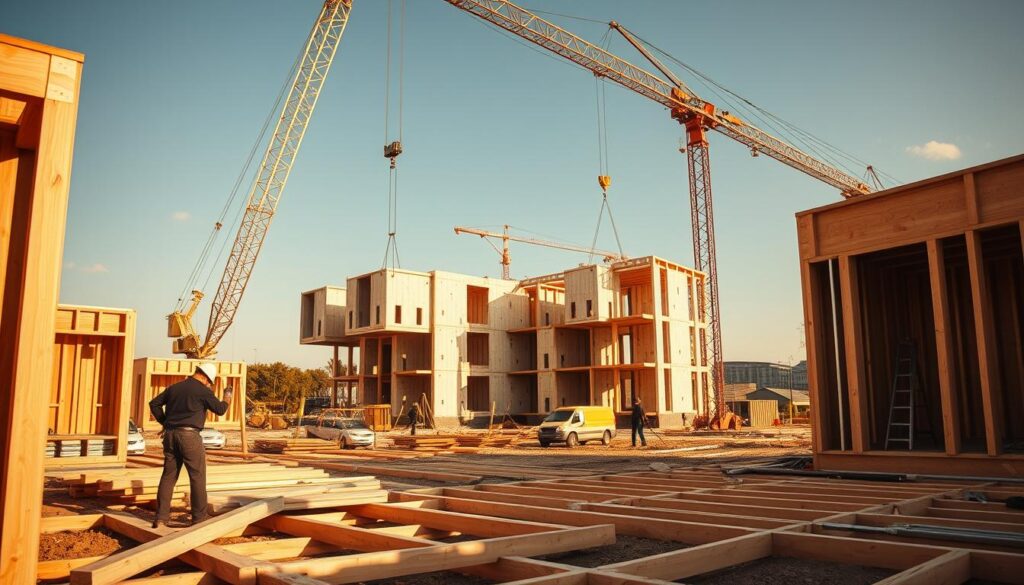The construction industry is witnessing a significant shift towards modular construction techniques, with a growing emphasis on efficiency and affordability. According to recent developments, prefab building methods are being utilized to advance lower-cost modular housing.
A notable collaboration between the National Renewable Energy Laboratory (NREL) and iUnit Communities is driving innovation in energy-efficient modular construction practices. This partnership is set to revolutionize the construction industry by making housing more affordable and sustainable.
Key Takeaways
- Efficient construction through modular techniques
- Affordable housing solutions through prefab methods
- Collaboration between NREL and iUnit Communities
- Advancements in energy-efficient construction practices
- Growing popularity of modular construction in the industry
Understanding Prefab Building Methods
Understanding prefab building methods is crucial for appreciating the advancements in modern construction techniques. Prefab construction involves manufacturing building components off-site under controlled conditions, which are then transported to the construction site for assembly.
What are Prefab Buildings?
Prefab buildings are structures made from pre-fabricated components manufactured in a factory. These components are designed to be easily assembled on-site, reducing the complexity and time required for construction. The process involves creating building elements such as walls, floors, and roofs in a controlled environment, ensuring high quality and precision.
The use of prefab buildings has gained popularity due to its efficiency and cost-effectiveness. According to a report, “Prefab construction can reduce project timelines by up to 50% compared to traditional construction methods.”
“The future of construction is in prefabrication, where buildings are constructed in a factory, reducing waste and improving quality.”
Key Advantages of Prefab Construction
Prefab construction offers several key advantages, including reduced material waste, lower labor costs, and improved quality control. The controlled manufacturing environment ensures that components are made to precise specifications, minimizing errors and defects.
- Speed: Prefab construction is significantly faster than traditional methods, as components are manufactured concurrently with site preparation.
- Cost-Effectiveness: Reduced labor costs and minimized material waste contribute to overall cost savings.
- Quality Control: The factory setting allows for rigorous quality control measures, ensuring high-quality components.
| Advantages | Prefab Construction | Traditional Construction |
|---|---|---|
| Speed | Faster due to concurrent manufacturing and site preparation | Slower due to sequential construction process |
| Cost | More cost-effective due to reduced waste and labor | More expensive due to higher labor costs and material waste |
| Quality | Higher quality due to controlled manufacturing environment | Variable quality due to on-site construction challenges |
Common Misconceptions About Prefab
Despite its benefits, prefab construction is often misunderstood. One common misconception is that prefab buildings are of lower quality. However, the controlled manufacturing environment ensures that components are made to precise specifications, resulting in high-quality structures.
Another misconception is that prefab buildings lack design flexibility. In reality, prefab construction allows for a wide range of customization options, enabling architects and builders to create unique and functional designs.
Types of Prefab Building Methods
There are several types of prefab building methods, including modular, panelized, pre-cut, and manufactured homes, each contributing to sustainable prefab building practices. These methods have gained popularity due to their efficiency, cost-effectiveness, and reduced environmental impact.
Modular Construction
Modular construction is a more advanced form of prefabrication, where entire building sections are created in a factory setting. This method allows for high-quality control and reduces on-site construction time significantly. Modular construction is particularly beneficial for projects that require rapid completion, such as hospitals or schools.
“Modular construction is revolutionizing the way we build, offering a faster, more efficient, and sustainable alternative to traditional construction methods.”
Panelized Construction
Panelized construction involves the fabrication of wall, floor, and roof panels in a factory, which are then assembled on-site. This method offers flexibility in design and can be more energy-efficient than traditional construction. Panelized construction is suitable for a wide range of building types, from residential homes to commercial buildings.
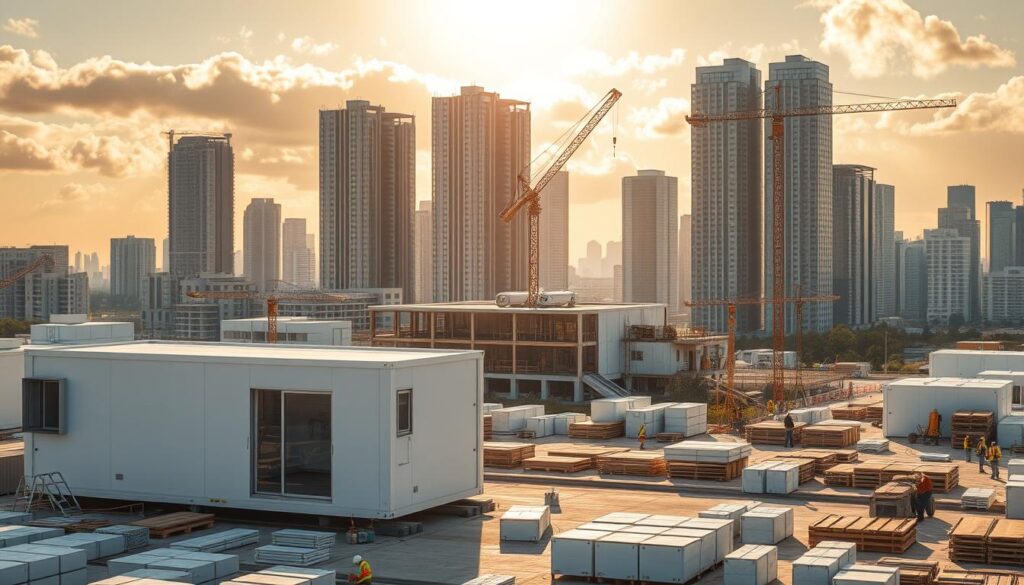
Pre-cut and Kit Homes
Pre-cut and kit homes involve the fabrication of building components, such as framing and roofing materials, which are then shipped to the site for assembly. This method provides cost savings and can be more environmentally friendly due to reduced waste. Pre-cut and kit homes are popular among homeowners who want to be involved in the construction process.
Mobile and Manufactured Homes
Mobile and manufactured homes are constructed in a factory and then transported to the site. These homes are built to strict building codes and can offer an affordable housing solution. Manufactured homes are often confused with modular homes, but they have distinct differences in terms of construction and placement.
| Prefab Method | Key Benefits | Typical Applications |
|---|---|---|
| Modular Construction | High-quality control, rapid construction | Hospitals, Schools |
| Panelized Construction | Flexibility in design, energy efficiency | Residential, Commercial |
| Pre-cut and Kit Homes | Cost savings, reduced waste | Residential Homes |
| Mobile and Manufactured Homes | Affordability, strict building codes | Residential Homes |
In conclusion, the various types of prefab building methods offer a range of benefits, from efficiency and cost-effectiveness to sustainability and quality control. By understanding these different methods, builders and homeowners can make informed decisions about their construction projects.
Benefits of Prefab Building
Prefab buildings offer a plethora of benefits that are transforming the way we construct homes and commercial spaces. The advantages of prefab construction are numerous, and they are revolutionizing the construction industry.
Speed of Construction
One of the most significant benefits of prefab construction is its ability to reduce construction time. Prefab buildings are constructed in a factory, where the environment is controlled, and the construction process is not affected by weather conditions. This leads to faster project completion and reduced labor costs.
Cost-Effectiveness
Prefab construction is a cost-effective modular building solution that offers significant cost savings compared to traditional construction methods. The reduced construction time, lower labor costs, and minimized waste all contribute to the cost-effectiveness of prefab buildings. For more information on the benefits of prefab construction, visit https://www.msuite.com/10-benefits-of-prefab-in-construction/.
Sustainability in Materials
Prefab construction emphasizes sustainability in materials, using eco-friendly materials that minimize environmental impact. The controlled factory environment allows for more efficient use of materials and reduced waste. This focus on sustainability is a significant advantage of prefab construction.
Quality Control Measures
Prefab construction involves rigorous quality control measures to ensure that the final product meets high standards. The factory environment allows for continuous monitoring and inspection, resulting in higher quality buildings. This attention to detail is a significant benefit of prefab construction.
The Prefab Building Process
Understanding the prefab building process is crucial for anyone looking to adopt efficient and affordable construction methods. The process involves several key stages that work together to deliver a high-quality building.
Design and Planning Stage
The first stage of the prefab building process is the design and planning phase. During this stage, architects and engineers work together to create a detailed design that meets the client’s needs and complies with local building codes. As noted by experts, “A well-planned design is the foundation of a successful prefab project.” Effective planning can help reduce costs and improve the overall quality of the building.
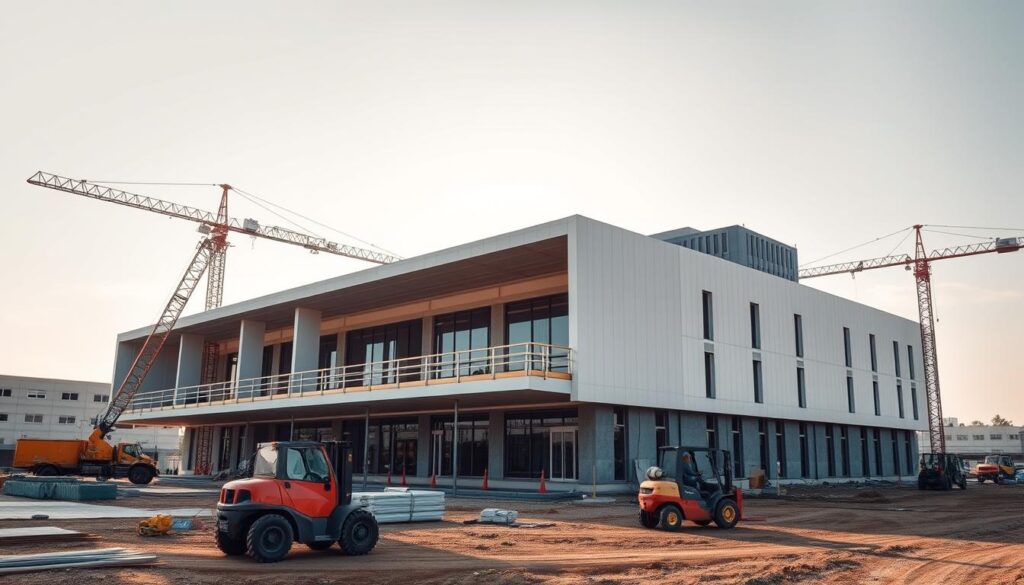
Manufacturing Phase
The manufacturing phase is where the prefab building components are produced in a factory. This stage is characterized by high levels of quality control and precision engineering. The use of advanced manufacturing techniques ensures that the components are durable and meet the required standards.
According to industry experts, “The factory-controlled environment of prefab construction allows for greater control over the building process, resulting in higher quality components.” The manufacturing phase is critical in ensuring that the final product meets the client’s expectations.
On-site Assembly Process
The final stage of the prefab building process is the on-site assembly. This involves transporting the prefab components to the building site and assembling them into the final structure. The on-site assembly process is typically faster than traditional construction methods, as the components are designed to fit together seamlessly.
Efficient on-site assembly is crucial for minimizing delays and ensuring that the project is completed on time. By leveraging modular construction techniques, builders can reduce the overall construction time and improve the quality of the final product.
In conclusion, the prefab building process is a highly efficient and effective method of construction that involves careful planning, precise manufacturing, and efficient on-site assembly. By understanding the different stages of the prefab building process, individuals can better appreciate the benefits of this innovative construction method.
Comparing Prefab vs. Traditional Construction
In the realm of construction, a critical comparison between prefab and traditional methods reveals distinct advantages and disadvantages. This section delves into the specifics of how prefab construction stacks up against traditional construction in terms of time, budget, and design flexibility.
Time Requirements
One of the most significant advantages of prefab construction is its ability to reduce the overall construction time. By manufacturing building components off-site, the on-site assembly process is significantly streamlined. This not only accelerates the construction timeline but also minimizes the impact of weather conditions on the build.
In contrast, traditional construction is often hampered by delays due to weather, labor shortages, or material delivery issues. The table below highlights a comparison of the construction timelines for prefab and traditional methods.
| Construction Method | Typical Construction Time |
|---|---|
| Prefab Construction | 3-6 months |
| Traditional Construction | 6-12 months |
Budget Considerations
Budget is a critical factor in any construction project. Prefab construction often offers cost savings due to the efficiency of off-site manufacturing and reduced on-site labor costs. Additionally, prefab methods can minimize waste and optimize material usage, further reducing expenses.
Traditional construction, while sometimes perceived as more expensive, can vary widely in cost depending on the project’s complexity and location. However, the economies of scale in prefab construction can make it a more budget-friendly option for many projects.
Flexibility in Design
Flexibility in design is another area where prefab and traditional construction methods differ. While traditional construction is often seen as more flexible due to the ability to make changes on-site, prefab construction has made significant strides in offering customizable designs without compromising its efficiency.
Modern prefab construction techniques allow for a wide range of design options, from modern aesthetics to more traditional looks, all while maintaining the benefits of off-site construction.
In conclusion, the comparison between prefab and traditional construction reveals that prefab methods offer significant advantages in terms of time and cost savings, while also providing flexibility in design. As the construction industry continues to evolve, understanding these differences is crucial for making informed decisions.
Permitting and Regulations for Prefab Homes
Navigating the regulatory landscape is a critical step in the successful completion of prefab home projects. Understanding and complying with local building codes and zoning regulations are essential for a smooth construction process.
Understanding Local Building Codes
Local building codes are sets of rules that govern the construction of buildings within a specific area. For prefab homes, these codes can dictate everything from the materials used to the energy efficiency standards. For instance, Orange County, Florida has specific guidelines for manufactured and mobile homes, highlighting the importance of researching local regulations.
Key aspects of local building codes include:
- Structural integrity and safety standards
- Energy efficiency requirements
- Environmental sustainability measures
Prefab builders often work closely with local authorities to ensure that their construction practices meet or exceed these codes. This collaboration is crucial for obtaining the necessary permits and avoiding costly delays.
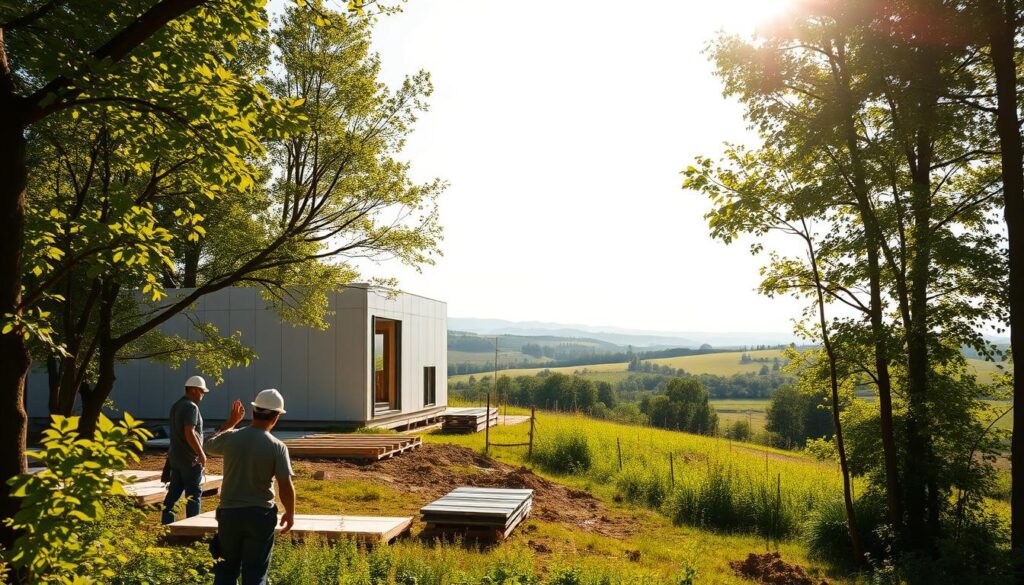
Navigating Zoning Issues
Zoning laws determine how land can be used within a particular area, including the types of buildings that can be constructed. For prefab homes, zoning regulations can be particularly challenging due to misconceptions about their quality and permanence.
Innovative prefab construction techniques are helping to address these challenges by providing designs that are not only compliant with zoning laws but also enhance the aesthetic appeal of prefab homes. This includes modular designs that blend seamlessly with traditional neighborhood architectures.
Steps to navigate zoning issues:
- Research local zoning laws and regulations
- Consult with local zoning authorities to understand specific requirements
- Work with prefab builders who have experience with local zoning issues
By understanding and addressing these regulatory challenges, prefab home builders can ensure that their projects are completed on time, within budget, and to the satisfaction of their clients.
Materials Used in Prefab Construction
The choice of materials in prefab construction plays a crucial role in determining the sustainability and cost-effectiveness of the building. As the construction industry continues to evolve, the use of advanced materials and techniques has become increasingly important.
Prefab construction utilizes a wide range of materials, from traditional to innovative eco-friendly options. The selection of materials depends on various factors, including the project’s budget, desired durability, and environmental considerations.
Eco-friendly Options
Eco-friendly materials are gaining popularity in prefab construction due to their reduced environmental impact. Some of the eco-friendly options include:
- Recycled Materials: Using recycled materials can significantly reduce construction costs and support sustainability goals.
- Sustainable Wood: Wood sourced from sustainably managed forests is a popular choice for eco-friendly prefab construction.
- Low-Carbon Concrete: Innovations in concrete production have led to the development of low-carbon alternatives that reduce the carbon footprint of construction projects.
According to recent studies, incorporating eco-friendly materials into prefab construction not only benefits the environment but also enhances the overall quality and durability of the building.
“Using recycled materials in construction can reduce waste and lower the demand for new raw materials, contributing to a more sustainable building process.”
Common Materials in Prefab Systems
In addition to eco-friendly options, traditional materials are still widely used in prefab construction due to their availability and cost-effectiveness.
Some common materials include:
- Steel Framing: Steel framing is valued for its strength, durability, and resistance to pests and decay.
- Insulated Panels: Insulated panels provide excellent thermal performance, reducing energy consumption and enhancing comfort.
- Engineered Wood Products: Engineered wood products, such as laminated veneer lumber (LVL), offer superior strength and stability compared to traditional lumber.
The use of advanced prefab assembly methods, combined with the right materials, can lead to cost-effective modular building solutions that meet the needs of a wide range of construction projects.
By understanding the materials used in prefab construction and their benefits, builders and homeowners can make informed decisions that balance cost, sustainability, and quality.
Prefab Buildings in Commercial Settings
Commercial construction is witnessing a significant shift with the adoption of prefab building methods, offering a range of benefits including speed, cost-effectiveness, and sustainability.
The versatility of modular construction techniques allows for a wide range of commercial applications, from office spaces to educational facilities. According to recent data, modular construction is particularly advantageous for multi-family homes, hotels, and office buildings, highlighting its potential in commercial settings.
Office Spaces
Prefab construction is being increasingly used in office spaces due to its ability to deliver high-quality, customized buildings quickly. This method allows businesses to occupy their new spaces sooner, reducing downtime and lost productivity. For more information on the differences between prefab construction methods, visit Mobile Modular’s blog.
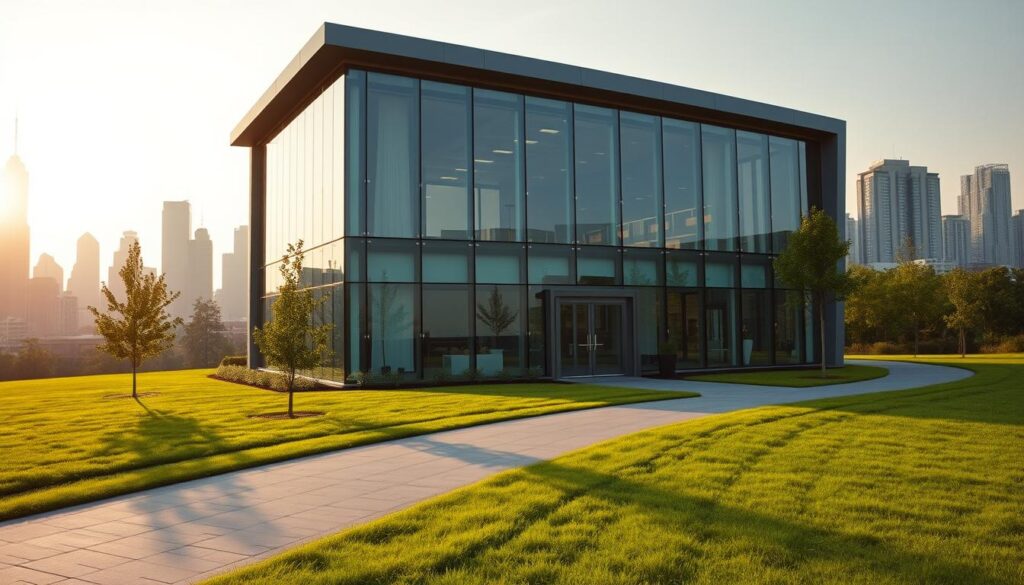
The use of modular construction techniques in office buildings also enables architects and builders to achieve complex designs that might be challenging or costly with traditional construction methods. This flexibility is a significant advantage in creating modern, functional office spaces that meet the evolving needs of businesses.
Retail Developments
In retail developments, prefab building methods offer the advantage of rapid deployment, allowing retailers to open their stores sooner. This speed can be crucial in competitive retail markets where being first to market or meeting a specific opening deadline is important.
Additionally, prefab construction can help in reducing the disruption typically associated with construction in or near operational retail environments. This minimizes the impact on existing businesses and customers, maintaining a smoother retail experience.
Educational Facilities
Educational facilities benefit significantly from prefab construction due to its speed and the ability to deliver high-quality learning environments. Schools and universities can quickly expand or renovate facilities using modular construction techniques, ensuring minimal disruption to educational activities.
The quality control inherent in prefab construction methods ensures that educational facilities are not only built quickly but also meet the required standards for safety and functionality. This is particularly important in educational settings where the environment plays a crucial role in the learning experience.
In conclusion, prefab building methods are transforming commercial construction by offering efficient, cost-effective, and sustainable solutions. As the industry continues to evolve, the adoption of modular construction techniques is expected to grow, driven by the demand for faster, more flexible, and environmentally friendly building practices.
Innovations in Prefab Technology
Innovations in prefab technology are revolutionizing the construction industry by enhancing efficiency and sustainability. The integration of advanced manufacturing techniques and smart home features is transforming the way prefab buildings are designed, constructed, and operated.
Advanced Manufacturing Techniques
Advanced manufacturing techniques are playing a crucial role in the evolution of prefab construction. Techniques such as 3D printing, modular construction, and panelized systems are improving the speed and quality of prefab buildings. For instance, the National Renewable Energy Laboratory (NREL) is developing and testing virtual construction training and testing spaces called Immersive Industrialized Construction Environments. These advancements are not only enhancing the construction process but also improving the sustainability of prefab buildings.
Some of the key benefits of advanced manufacturing techniques in prefab construction include:
- Increased Efficiency: Streamlined processes reduce construction time.
- Improved Quality: Controlled manufacturing environments ensure higher quality finishes.
- Sustainability: Reduced waste and energy-efficient materials contribute to more sustainable buildings.
Smart Home Features
Smart home features are becoming increasingly popular in prefab construction, offering homeowners enhanced convenience, energy efficiency, and security. These features include:
- Automated Lighting and Temperature Control: Systems that adjust based on occupancy and time of day.
- Energy Monitoring Systems: Real-time monitoring of energy usage to optimize consumption.
- Smart Security Systems: Integrated security cameras and alarm systems that can be controlled remotely.
The incorporation of smart home features in prefab buildings is not only enhancing the living experience but also contributing to the overall sustainability of the buildings.
Financing Your Prefab Project
As prefab construction continues to grow, exploring financing options becomes increasingly important. Financing a prefab project involves understanding the various loan options available and creating a budget that accounts for the unique aspects of prefab construction.
Loan Options for Prefab Buildings
Several loan options are available for financing prefab buildings, including construction loans and mortgages specifically designed for prefab homes. Construction loans provide funds for the construction phase, while prefab mortgages offer long-term financing solutions.
A key consideration when choosing a loan is the interest rate and repayment terms. It’s essential to compare different lenders and loan products to find the best fit for your prefab project.
| Loan Type | Interest Rate | Repayment Term |
|---|---|---|
| Construction Loan | 4.5% | 12 months |
| Prefab Mortgage | 3.75% | 30 years |
Budgeting for Your Prefab Home
Budgeting for a prefab home requires careful planning to ensure that all costs are accounted for. This includes the cost of the prefab unit, land acquisition, site preparation, and assembly.
Using cost-efficient construction methods can help project managers stay within budget. Innovative prefab construction techniques can also reduce costs by minimizing waste and optimizing material usage.

By understanding the financing options and budgeting strategies available, you can successfully fund your prefab project and enjoy the benefits of sustainable prefab building practices.
Landscaping and Exterior Finishing
Landscaping and exterior finishing are the final touches that transform a prefab structure into a home. These elements not only enhance the aesthetic appeal but also contribute to the overall value of the property.
When it comes to customizing outdoor spaces, homeowners have a wide range of options. From creating inviting patios to designing lush gardens, the possibilities are endless. Incorporating locally sourced materials can not only minimize transportation expenses but also support sustainability goals, aligning with the principles of cost-effective modular building solutions.
Customizing Outdoor Spaces
Customizing outdoor spaces involves more than just planting trees or flowers. It’s about creating an environment that complements the prefab home. This can include:
- Designing walkways and patios that integrate with the home’s architecture
- Incorporating outdoor lighting to highlight the home’s features
- Selecting plants and greenery that thrive in the local climate
As noted by a recent study, “using locally sourced materials can reduce the carbon footprint of a project and enhance its aesthetic appeal by blending it with the surrounding environment.”
“Sustainability is no longer a choice but a necessity in modern construction.”
Choosing Materials for Curb Appeal
The choice of materials for exterior finishing can significantly impact the curb appeal of a prefab home. Options range from traditional materials like brick and wood to more modern choices such as composite materials. The key is to select materials that are not only visually appealing but also durable and low maintenance.
Incorporating advanced prefab assembly methods can also streamline the process of exterior finishing, ensuring that the materials used are of high quality and properly integrated into the home’s design.
| Material | Durability | Maintenance |
|---|---|---|
| Brick | High | Low |
| Composite | Medium | Low |
| Wood | Medium | Medium |
Real-Life Examples of Successful Prefab Projects
Successful prefab projects showcase the potential of modular construction techniques in real-world applications. These projects demonstrate the efficiency, affordability, and sustainability of prefab building methods.
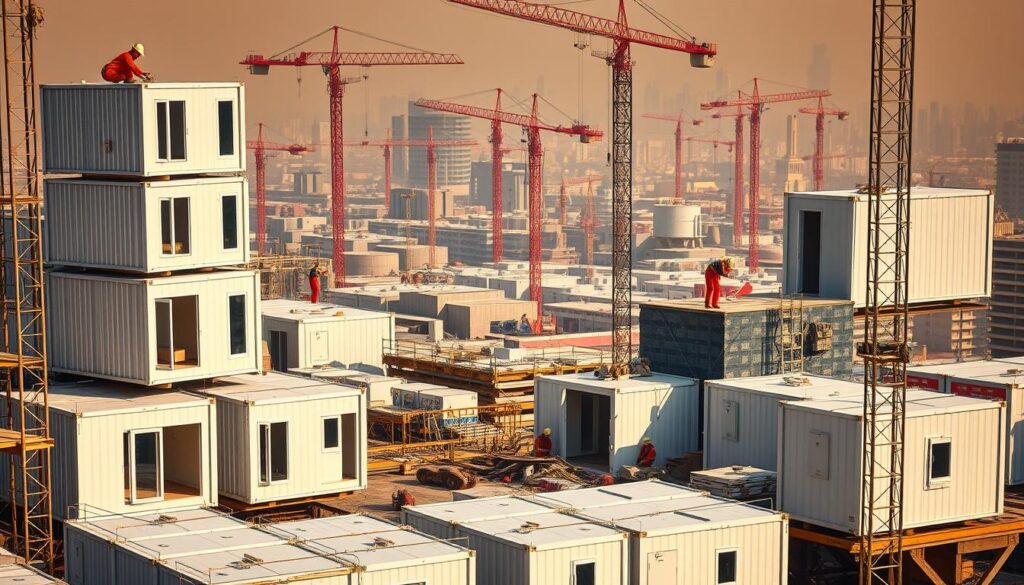
The collaboration between NREL and iUnit Communities on a modular apartment prototype is a notable example. This project highlights the benefits of prefab construction, including reduced waste and improved quality control.
Case Studies of Unique Builds
Several case studies illustrate the versatility of prefab building methods. For instance, projects featured on ArchDaily demonstrate innovative uses of prefab construction in various settings, from residential homes to commercial buildings.
| Project | Location | Features |
|---|---|---|
| NREL Modular Apartment | Colorado, USA | Sustainable materials, energy-efficient design |
| iUnit Communities | Various locations | Modular construction, customizable designs |
| Prefab Office Building | California, USA | Rapid construction, eco-friendly materials |
Lessons Learned from Prefab Successes
The success of these prefab projects offers valuable lessons for future developments. Key takeaways include the importance of effective project planning, collaboration between stakeholders, and adaptability to local building codes and regulations.
By examining these real-life examples and case studies, it’s clear that prefab building methods and modular construction techniques are poised to play a significant role in the future of construction.
Future Trends in Prefab Construction
The prefab construction industry is on the cusp of a revolution, driven by technological advancements and changing consumer demands. As the industry continues to evolve, it’s essential to understand the trends that will shape its future.
Predictions for Market Growth
The demand for prefab construction is expected to rise significantly in the coming years, driven by the need for efficient, cost-effective, and sustainable building solutions. According to industry forecasts, the global prefab construction market is projected to experience substantial growth, with an increasing number of projects adopting off-site construction methods. For more information on prefab builders, you can visit https://worldcivilsociety.com/home-builders/.
This growth can be attributed to the numerous benefits offered by prefab construction, including reduced construction time, improved quality control, and minimized environmental impact. As the industry continues to mature, we can expect to see increased adoption of prefab construction methods across various sectors, including residential, commercial, and industrial projects.
Impact of Technology Innovations
Technological innovations are playing a crucial role in shaping the future of prefab construction. Advances in pre-fabricated construction processes and manufacturing technologies are enabling the production of high-quality, customized building components with increased efficiency and reduced waste.
The integration of technologies such as Building Information Modeling (BIM), automation, and robotics is also enhancing the prefab construction process, allowing for improved precision, reduced labor costs, and increased productivity. Furthermore, the use of sustainable materials and energy-efficient systems is becoming more prevalent, contributing to a more environmentally friendly construction industry.
As the prefab construction industry continues to evolve, it’s clear that technology will remain a key driver of innovation and growth. By embracing these advancements, companies can stay ahead of the curve and capitalize on the opportunities presented by this rapidly changing market.
Choosing the Right Prefab Builder
The key to a successful prefab project lies in choosing the right builder. With the growing popularity of prefab construction, the market is filled with various builders offering different services and qualities. Therefore, it’s crucial to evaluate potential builders carefully to ensure they can deliver your project efficiently and to the desired standard.
Evaluating Quality and Experience
When evaluating potential prefab builders, their quality of work and experience are paramount. Look for builders who have a proven track record in delivering high-quality prefab projects. Check their portfolio for examples of previous work, and ask for references to gauge their reliability and professionalism. A builder with extensive experience in sustainable prefab building practices and innovative prefab construction techniques can significantly enhance the outcome of your project.
- Review their portfolio for similar projects.
- Ask for client references and testimonials.
- Check for any industry certifications or awards.
It’s also beneficial to visit some of their completed projects, if possible, to assess the quality firsthand. This step can provide valuable insights into the builder’s attention to detail and overall craftsmanship.
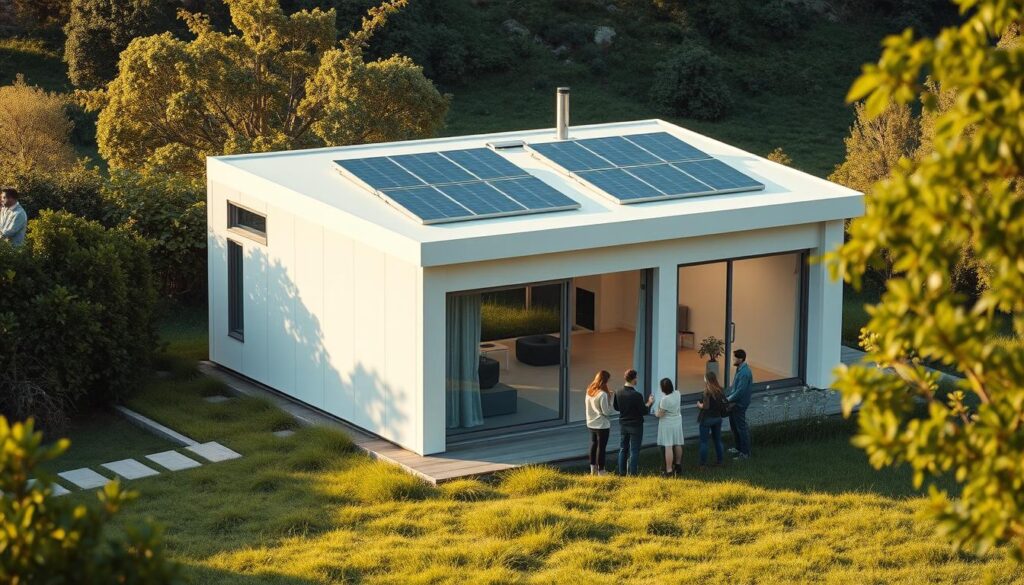
Questions to Ask Potential Builders
To further assess the suitability of a prefab builder, prepare a list of questions to ask during your initial consultations. Some key questions to consider include:
- What experience do you have with prefab projects similar to mine?
- Can you provide a detailed breakdown of the costs involved?
- How do you ensure quality control during the manufacturing and assembly phases?
- What is your timeline for completing the project, and what are the key milestones?
- Do you have any recommendations for prefab home builders or suppliers that you work with?
By asking these questions, you can gain a better understanding of the builder’s capabilities, their approach to prefab construction, and how they can meet your specific needs. A transparent and communicative builder is more likely to deliver a successful project.
In conclusion, choosing the right prefab builder involves thorough research and evaluation. By focusing on their quality of work, experience, and ability to communicate effectively, you can ensure that your prefab project is completed to the highest standards.
Overcoming Challenges in Prefab Construction
As prefab construction continues to evolve, understanding and mitigating its challenges is crucial for delivering projects on time and within budget. Despite its many benefits, prefab construction faces unique obstacles that can impact its success.
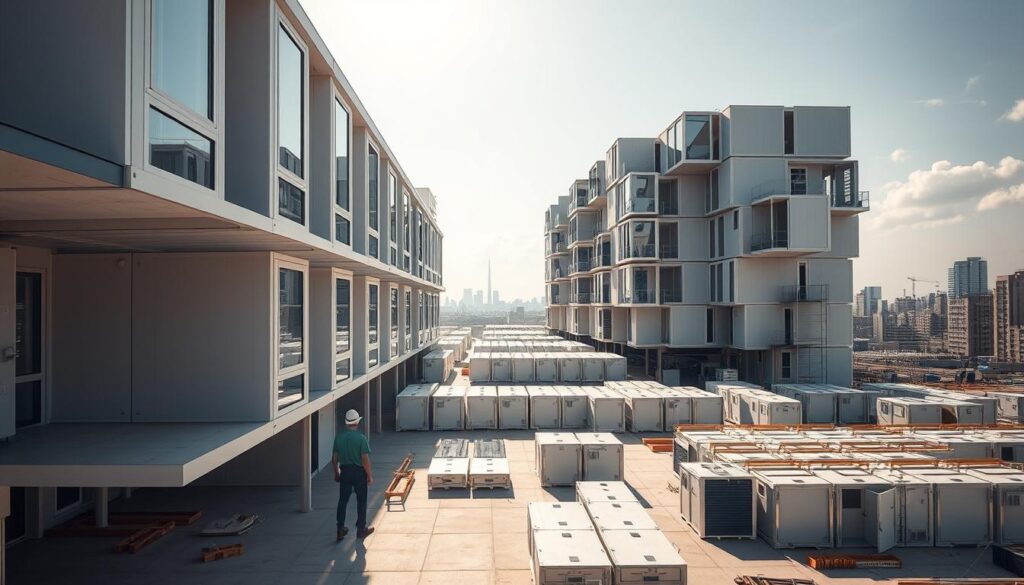
Addressing Supply Chain Issues
One of the significant challenges in prefab construction is managing the supply chain. Disruptions can lead to delays and increased costs. To address this, project managers can adopt advanced prefab assembly methods that streamline the manufacturing process and reduce reliance on complex supply chains.
- Develop strong relationships with suppliers to ensure reliability and flexibility.
- Implement just-in-time delivery systems to minimize inventory and reduce waste.
- Consider local sourcing to reduce transportation costs and support the local economy.
According to industry experts, adopting modern construction methods can help project managers stay within budget and deliver high-quality results. By leveraging cost-effective modular building solutions, builders can reduce waste and improve efficiency.
“The key to successful prefab construction lies in meticulous planning and coordination. By understanding the potential challenges and proactively addressing them, project managers can ensure the successful delivery of prefab projects.”
Managing Expectations
Managing client expectations is crucial in prefab construction. Clear communication about the process, timelines, and potential challenges can help set realistic expectations and build trust.
- Provide regular updates on project progress to keep clients informed.
- Be transparent about potential challenges and how they will be addressed.
- Offer flexible solutions to accommodate client needs while maintaining project integrity.
By adopting a proactive approach to managing expectations and addressing supply chain issues, prefab construction projects can overcome common challenges and achieve success. Utilizing advanced prefab assembly methods and cost-effective modular building solutions can further enhance project outcomes.
The Role of Prefab in Affordable Housing Initiatives
Prefab construction is emerging as a viable solution for affordable housing initiatives. With the increasing demand for housing, traditional construction methods are often proving to be too slow and costly. Prefab building methods, including modular construction techniques, offer a faster and more cost-effective alternative.
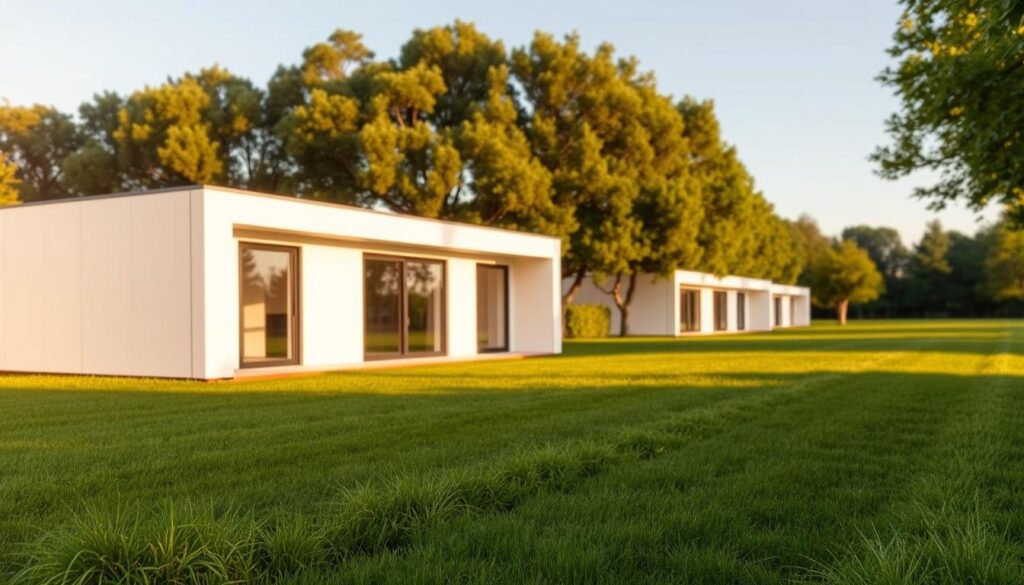
Meeting Housing Demands
The United States is facing a significant housing shortage, with many communities struggling to provide affordable housing options. Prefab construction can help address this issue by providing a rapid and efficient means of building homes. According to a report by the National Renewable Energy Laboratory (NREL), projects like iUnit Communities are leveraging modular construction to develop affordable housing.
Prefab building methods can help meet housing demands in several ways:
- Faster construction times, allowing for quicker occupancy
- Reduced labor costs due to efficient manufacturing processes
- Improved quality control, resulting in fewer defects and less waste
As noted by experts,
“Prefab construction is not just a method of building; it’s a way to revolutionize the construction industry by making it more efficient, sustainable, and affordable.”
Case Studies of Affordable Projects
Several case studies highlight the success of prefab construction in affordable housing initiatives. For instance, a project in Phoenix utilized modular construction techniques to build affordable housing units. The project was completed ahead of schedule and under budget, demonstrating the potential of prefab construction.
| Project | Location | Construction Time | Cost Savings |
|---|---|---|---|
| iUnit Communities | Multiple Locations | 30% faster | 25% less |
| Phoenix Modular Housing | Phoenix, AZ | 40% faster | 20% less |
For more information on the role of architects in prefab construction for affordable housing, visit PMI PHX.
Conclusion: The Future of Prefab Building Methods
The construction industry is on the cusp of a revolution, driven by the adoption of pre-fabricated construction processes and off-site construction methods. As discussed, prefab building methods offer numerous benefits, including reduced construction time, minimized on-site waste, and improved quality control.
Embracing sustainable prefab building practices is crucial for the future of the industry. By adopting modern construction methods, builders can stay competitive while reducing their environmental footprint. The use of sustainable materials in prefabrication contributes to a more sustainable building process, offering benefits such as improved energy efficiency and enhanced indoor air quality.
Innovations Shaping the Industry
As the industry continues to evolve, innovations in prefab technology will play a significant role in shaping its future. Advanced manufacturing techniques and smart home features are just a few examples of the innovations driving growth in the prefab sector. For more information on emerging green building innovations, visit World Civil Society.
Final Thoughts
The future of prefab building methods looks promising, with potential for significant growth and innovation. By understanding the benefits and challenges of prefab construction, builders and developers can make informed decisions about adopting these modern construction methods.
